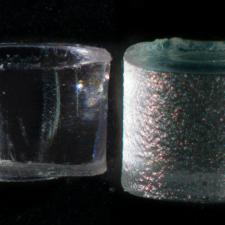plasticker-News
| 2008-11-26 |

|
Automatik Plastics Machinery + Bühler: Direct crystallization saves energy
|
Direct crystallization allows significant energy savings in the production of PET and crystallisable polyester. The CC-PET® process developed by Automatik Plastics Machinery GmbH (www.automatikgroup.com) and Bühler AG (www.buhlergroup.com) combines this benefit with the robustness and flexibility expected of stateof-the-art production processes and supplies a dust-free product of stable quality. The production of different types of polyester today is a large-scale industry with tried and true, cost-effective manufacturing methods. Despite the trend toward plants offering economies of scale and the fine-tuning of all process stages, the largest potential for further cost reductions lies in the interfaces between the different process stages. One such interface exists after the pelleting stage, which links melt-phase polymerization with downstream solid-state polycondensation. This interface can be optimized by direct combination of the pelleting crystallization. This so-called direct crystallization is an eminently important development enabling energy consumption to be reduced during polyester production. It allows the energy contained in the polyester melt to be utilized for the crystallization stage. This direct crystallization eliminates the need for intermediate storage. This offers cost advantages, but at the same time increases the complexity of the overall process because previously independent operations are now combined. Water-cooled The direct crystallization process starts at the extrusion die, where the melt is formed into several strands of uniform thickness. Depending on the specific pelleting process applied, the strands will be maintained over a short distance and are partially cooled with water before being cut into pellets. The cooling water is maintained at a temperature of 60 to 95 °C. It is preferably separated from the pellets by a centrifugal dryer, with the pellets then being transferred to a crystallizer. In the crystallizer, the pellets are agitated by a fluidizing gas stream in order to prevent agglomeration. For higher throughput rate, several pelleting systems may converge in a single crystallizer. The total contact time with the water is typically in the range of 1 to 4 seconds. As an option, a screen may be used for separating oversize pellets, dust, and fines. The main goal of the direct crystallization process is to transfer an optimal amount of energy from the melting process to the crystallization process. This optimum is not determined only by the reduction of energy consumption, but also by additional factors such as process stability, product quality, and operating flexibility. Temperature fluctuations can be balanced by supplying a controlled amount of heat to the fluidizing gas stream. This low “loss” of energy saved ensures permanently constant process conditions and thus a homogeneous product quality. At the same time, the process can absorb a certain portion of cold material from the outside. If the melt-phase polymerization process is temporarily operated independently of the solid-stage treatment, this material can be returned later on to the process – a significant advantage in plants which are sometimes operated for several years without interruption. Joint development Automatik Plastics Machinery and Bühler AG, the market leaders in the supply of plants for manufacturing PET pellets and in the field of solid-state polycondensation, have jointly developed the Combi-Crystal-PET® (CC-PET®) process. It optimizes direct crystallization for maximum energy savings and process stability. This process can be used both for underwater strand granulation (USG, cylindrical pellets) and for underwater granulation (UWG, spherical pellets). Both granulation systems can be linked directly with the Buhler Q-crystallizer. A typical application of the CC-PET® process is the production of PET with a low to average comonomer degree and an intrinsic viscosity between 0.55 and 0.9 dl/g. With lower viscosities and higher comonomer degrees, an intermediate conditioning stage is provided in the cooling fluid. An additional benefit of the CC-PET® process is that pellets with a higher surface roughness can be manufactured, which further reduces the stickiness of the pellets. The surface roughness is achieved without the dust generation otherwise typical of crystallization processes applying mechanical agitation. Quite the contrary is true: The CC-PET® process incorporates an integrated dedusting stage. Photo: Amorphous pellets from the CC-PET process with increased surface roughness (right) – Amorphous pellets from a conventional granulation process without surface roughness (left). |
Automatik Plastics Machinery GmbH + Bühler AG, Grossostheim + Uzwil, Switzerland
 back to news list back to news list |  back to top back to top |












